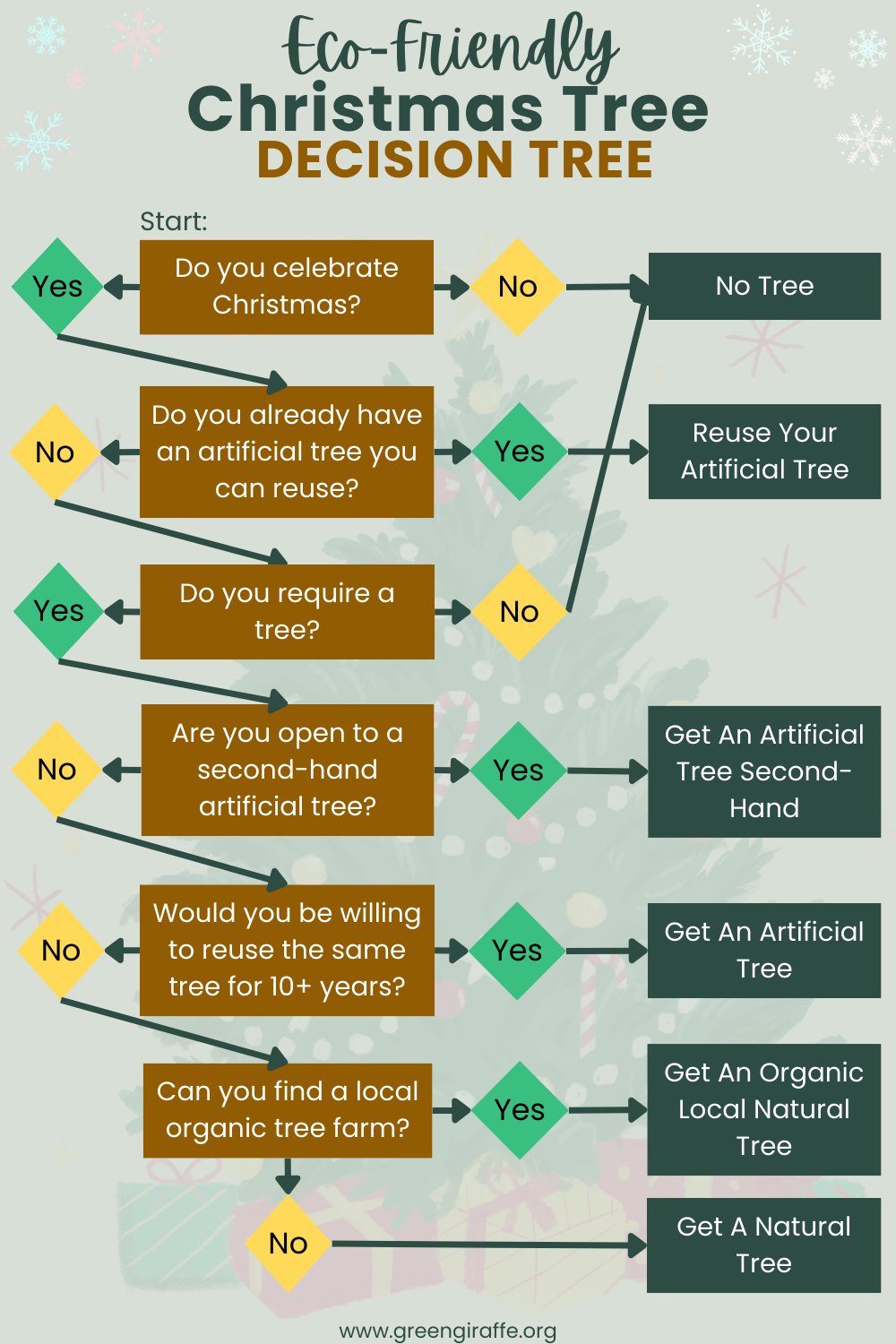Eco-Friendly Living & Christmas Trees: A Pros and Cons List
Introduction
As the holiday season approaches, and while trying to become more eco-friendly, should you go for a natural, artificial, or no Christmas tree? There are pros and cons to each. While every small environmentally friendly change makes a difference to our planet, the most sustainable choice here can be difficult for many to make. The most sustainable choice is no tree at all (which is the same answer for buying most things!).
However, each choice has unique pros and cons, and making the right decision is a personal one. In this article, we'll break down the advantages and disadvantages of all three options—natural trees, artificial trees, or forgoing a tree entirely, with a heightened focus on environmental sustainability. Let's embark on a festive journey to help you make the best choice for your holiday season.
If you’d rather skip the reading, try this decision tree to help get to the best answer for you.
Decision Tree:
Do you celebrate Christmas?
No → No Tree
Yes → Continue to question #2
Do you already have an artificial tree you can reuse?
Yes → Reuse your artificial tree
No → Continue to question #3
Do you require a tree?
No → No Tree
Yes → Continue to question #4
Are you open to a second-hand artificial tree?
Yes → Get an Artificial Tree second-hand
No → Continue to question #5
Would you be willing to reuse the same tree for 10+ years?
Yes → Get an Artificial Tree
No → Continue to question #6
Can you find a local organic tree farm?
Yes → Get an organic local Natural Tree
No → Get a Natural Tree
Natural Christmas Trees
Pros:
Authenticity: Nothing beats the genuine charm of a natural Christmas tree. Its natural scent and rustic appearance create a warm and cozy ambiance that's hard to replicate.
Traditional Delight: For many, the tradition of selecting, decorating, and caring for a live tree is a cherished part of the holiday season. It's a memorable experience that brings families closer.
Carbon Sequestration: Growing natural trees captures carbon dioxide from the atmosphere, helping combat climate change.
Supporting Local Economies: Purchasing from local tree farms can boost your community's economy.
Renewable Resource: Trees are renewable resources, and new ones are often planted to replace harvested ones.
Habitat for Wildlife: Tree farms can provide habitats for wildlife, supporting biodiversity.
Reduced Plastic Use: Natural trees eliminate the use of plastics common in artificial trees.
Recyclable: Many communities offer tree recycling programs that turn them into mulch or compost.
Cons:
Maintenance: Natural trees require regular watering to keep them fresh and prevent needle shedding. This upkeep can be time-consuming, especially with a busy holiday schedule.
Clean-up: Dealing with fallen needles and disposing of the tree after the holiday season can be a bit messy.
Allergies: Natural trees can release pollen and mold spores, triggering allergies in some individuals and potentially putting a damper on the festivities.
Pesticides and Fertilizers: Most Christmas tree farms use pesticides and fertilizers. These end up in the soil, groundwater, and nearby bodies of water. They may also use excessive water.
Deforestation Concerns: Unsustainable tree harvesting practices can lead to deforestation.
Transportation Emissions: The environmental impact can increase if the trees are transported over long distances.
Limited Lifespan: Natural trees have a short lifespan and are typically discarded after the holidays.
Waste Generation: Disposal creates waste and may contribute to landfill use. Those that end up in the landfill will contribute to greenhouse gasses.
Artificial Christmas Trees
Pros:
Durability: Artificial trees can last for many years, making them a cost-effective option over time. You can reuse the same tree for several holiday seasons.
Low Maintenance: These trees are virtually maintenance-free. There is no need to water them, and they don't shed needles. They maintain their shape and appearance throughout the holiday season.
Versatility: Artificial trees come in various styles, colors, and sizes. You can choose one that perfectly complements your decorating theme and space.
Reduced Carbon Emissions: Long-term use lowers the carbon footprint associated with tree production (better than a commercially grown tree after 10 years).
Eco-Friendly Materials: Some artificial trees are made from recyclable or sustainable materials.
No Deforestation: Artificial trees don't contribute to deforestation.
Reduced Allergen Impact: Artificial trees don't release allergens.
Cons:
Initial Cost: High-quality artificial trees can be pricey upfront. While they may save you money over time, the initial investment may deter some.
Lack of Scent: Artificial trees lack the delightful natural fragrance of a real tree, which is an integral part of the holiday ambiance for many.
Non-Biodegradable: Most artificial trees are made from non-recyclable materials, contributing to plastic waste having a negative environmental impact.
Long Lifespan: The durability of artificial trees can lead to excessive waste in the long run.
Energy-Intensive Production: Manufacturing artificial trees consumes energy and resources.
Initial Carbon Footprint: Producing and shipping artificial trees has an initial carbon footprint.
No Christmas Tree (The Most Sustainable)
Pros:
Space and Allergies: If you have limited space or family members with allergies, not having a tree can be a practical and health-conscious choice.
Endless Creativity: Without a traditional tree, you can explore alternative decorations or unique holiday themes. It's a chance to let your creative spirit shine.
Environmental Impact: Choosing not to have a tree is the most environmentally friendly option. You're reducing the demand for both natural trees and artificial trees, which can have significant environmental footprints.
Reduced Resource Consumption: No tree means no resources are used for production.
Lower Carbon Footprint: The environmental impact is minimal without a tree.
Minimal Waste: Going treeless reduces waste generation.
Encourages Minimalism: A minimalist approach can reduce consumption.
Focus on Sustainable Decor: You can concentrate on sustainable decorations.
Cons:
Nostalgia: The absence of a Christmas tree may evoke a sense of nostalgia and tradition that you and your loved ones might miss during the holiday season.
Decorative Void: The central decorative piece of many holiday celebrations, the tree is a focal point for ornaments and lights. Going treeless may leave a decorative gap.
Conclusion
Choosing between a natural, artificial, or no Christmas tree is personal. The choice should align with your lifestyle, values, traditions, and sustainability considerations. Natural trees offer authenticity and tradition but require maintenance and raise concerns about deforestation. Artificial trees provide convenience and durability but come with environmental concerns related to non-recyclable materials. Going treeless is the most environmentally friendly option. It offers creative freedom but may lack the nostalgia of a decorated tree.
In the end, remember that the essence of the holiday season lies in the joy of spending time with loved ones, sharing moments of warmth and cheer, and spreading goodwill. The choice of a Christmas tree, or lack thereof, should enhance your celebration and create lasting memories. So, whether your heart longs for the scent of pine, the sparkle of an artificial tree, or the open canvas of a treeless celebration, may your holiday be filled with the magic of the season.








